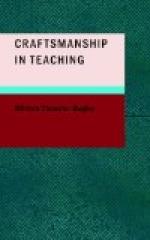In the narrower sense, however, the art of study may be said to consist in the ability to assimilate the experiences of others, and it is in this narrower sense that I shall discuss the problem to-day. It is not only in books that human experience is recorded, and yet it is true that the reading of books is the most economical means of gaining these experiences; consequently, we may still further narrow our problem to this: How may pupils be trained effectively to glean, through the medium of the printed page, the great lessons of race experience?
The word “study” is thus used in the sense in which most teachers employ it. When we speak of a pupil’s studying his lessons, we commonly mean that he is bending over a text-book, attempting to assimilate the contents of the text. Just what it means to study, even in this narrow sense of the term,—just what it means, psychologically, to assimilate even the simplest thoughts of others,—I cannot tell you, and I do not know of any one who can answer this seemingly simple question satisfactorily. We all study, but what happens in our minds when we do study is a mystery. We all do some thinking, and yet the psychology of thinking is the great undiscovered and unexplored region in the field of mental science. Until we know something of the psychology of thinking, we can hope for very little definite information concerning the psychology of study, for study is so intimately bound up with thinking that the two are not to be separated.
But even if it is impossible at the present time to analyze the process of studying, we are pretty well agreed as to what constitutes successful study, and many rules have been formulated for helping pupils to acquire effective habits of study. These rules concern us only indirectly at the present time, for our problem is still narrower in its scope. It has to do with the possibility of so training children in the art of study, not only that they may study effectively in school, but also that they may carry over the habits and methods of study thus acquired into the tasks of later life. In other words, the topic that we are discussing is but one phase of the problem of formal discipline,—the problem of securing a transfer of training from a specific field to other fields; and my purpose is to view this topic of “study” in the light of what we know concerning the possibilities of transfer.
Let me take a specific example. I am not so much concerned with the problem of getting a pupil to master a history lesson quickly and effectively,—not how he may best assimilate the facts concerning the Missouri Compromise, for example. My task is rather to determine how we can make his mastery of the Missouri Compromise a lesson in the general art of study,—how that mastery may help him develop what we used to call the general power of study,—the capacity to apply an effective method of study to other problems, perhaps, very far removed from the history lesson; in other words, how that single lesson may help him in the more general task of finding any type of information when he needs it, of assimilating it once he has found it, and of applying it once he has assimilated it.




